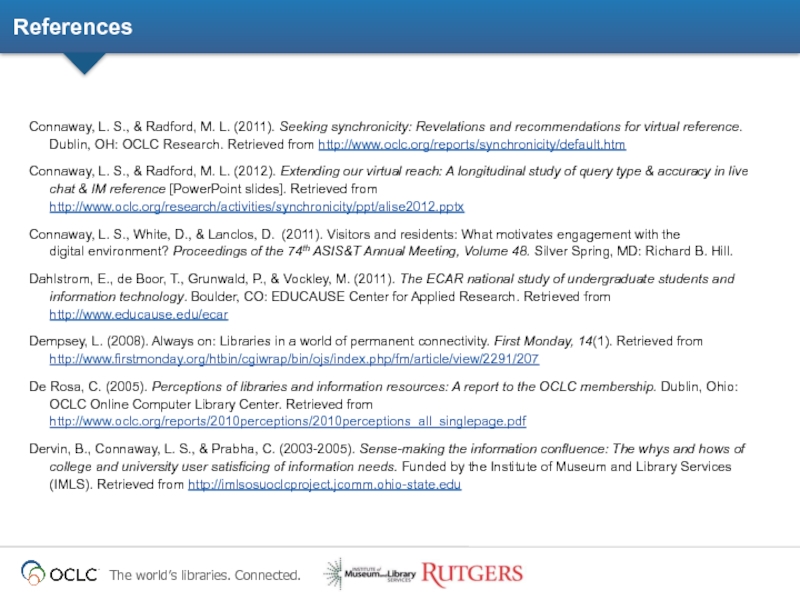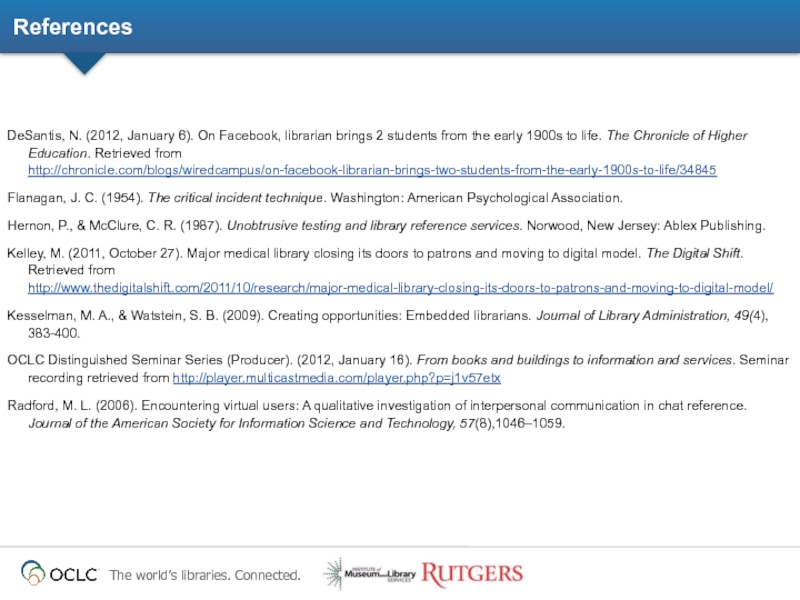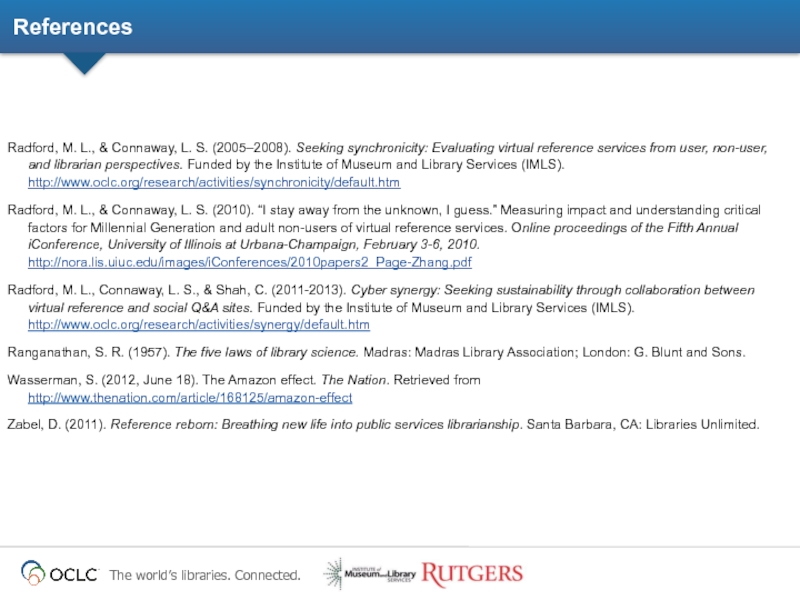Слайд 1Using Virtual Reference Services to Embed the Library in the Academic
Workflow
Gramado, Brazil • September 19, 2012
The XVII Seminário Nacional de Bibliotecas Universitárias
Lynn Silipigni Connaway, Ph.D.
Senior Research Scientist
OCLC Research
Слайд 2“The convenience is still better online than in person, you don’t
have to make trips to the library.”
(UTI-24, MALE 15-18 YEARS OLD)
library
Слайд 3Then & Now
Then: The user built workflow around the library
Now: The
library must build its services around user workflow
Then: Resources scarce, attention abundant
Now: Attention scarce, resources abundant
(Dempsey, 2008)
Слайд 5Virtual Reference Services
Global reach
Anytime/anywhere access
Cooperative services may reduce costs
Слайд 6The Study
Seeking Synchronicity
Seeking Synchronicity
Слайд 7Seeking Synchronicity:
Evaluating Virtual Reference Services from User, Non-User & Librarian Perspectives
Studied
habits & needs of virtual reference service (VRS) librarians, users, & non-users to identify characteristics for informing library system & service development
Generalizable through large sample sizes, multiple methods of data collection, & triangulation of results
Librarians
Users
Non-users
(Connaway & Radford, 2011)
Слайд 8Seeking Synchronicity Phases
Phase II:
Transcript Analysis
850 QuestionPoint live chat transcripts
Phase III:
Telephone Interviews
100
VRS Librarians
76 VRS Users
107 VRS Non-users
Phase IV:
Online Surveys
173 VRS Librarians
137 VRS Users
134 VRS Non-users
Phase I:
Focus Group Interviews
Слайд 9Critical Incident Technique (CIT) for Telephone Interviews & Survey
Flanagan (1954)
Qualitative technique
Focuses
on most memorable event/experience
Allows categories or themes to emerge rather than be imposed
(Flanagan, 1954)
Слайд 10Critical Incident Technique (CIT) for Telephone Interviews & Survey
VR Users’ &
Librarians’ Questions
Remember 1 specific successful VRS interaction
Remember 1 specific unsuccessful VRS interaction
Describe each interaction
Identify factors that made interactions successful or unsuccessful
Слайд 11Seeking Synchronicity
Types of questions
Types of Questions
Слайд 12how do you spell I miss you in spanish
Is “The Mindful
Child: How to Help Your Kid Manage Stress and Become Happier, Kinder, and More Compassionate” Available?
What politician supports gay rights and or is an activist for them
QP2-282
how many books can i check out at one time?
QP2-276
How do I get a job and what are the requirements?
QP2-274
I need some help with finding articles
QP2-273
I need a good website all about the history of DESIGN of telephones with a timeline and good pictures with it.
QP2-269
Cannot log in, telling me authentication failed. Was able to log in yesterday.
QP2-269
Слайд 13Types of VR Questions
Subject Search
Ready Reference
Procedural
No Question
Holdings
Research
Inappropriate
Directional
Reader’s Advisory
(Arnold & Kaske, 2002,2005)
Слайд 14Subject Search or Specific Search
“Almost always takes the form of giving
the user a document, for example, a list of citations, a book, or a report” (Arnold & Kaske, 2005).
Where can i find information about ADHD?
(QP2–005)
How was the labeling theory important in deinstitutionalization?
(QW–023)
can you help me find poems by Maya Angelou and criticism on them? (QP1–230)
Слайд 15Ready Reference
“These are the typical ready-reference or data queries that require
only a single, usually uncomplicated, straightforward answer...Who? What? When? Why? Where?” (Arnold & Kaske, 2005).
who won the world cup game between south africa and france?
(QW–024)
Who was Bentonville, NC named after?
(QP1–147)
How do i cite a political talk show in MLA format?
(QP2–013)
Слайд 16 Procedural
“Questions pertaining to the policies or procedures within the
library system” (Arnold & Kaske, 2005).
Can I get summer long term renewals online? How? (QP1–004)
what is the max for checkout on blu ray dvids? (QW–033)
need access logon info to lexis from scool library website (QP2– 027)
Слайд 17Holdings
“Questions about specific holdings of a library in print or digital
form” (Arnold & Kaske, 2005).
I was wondering if you have textbooks to rent for an hour or 2?
(QP2–172)
Do you have any books on Paris Hilton? (doing a project on her)
(QP 1–195)
hi there; i was wondering if you guys have Moby Dick in stock?
(QW–014)
Слайд 18Research
“Research questions… involve trial-and-error searching or browsing… [and] are usually identified
as coming from an adult specialist who is seeking detailed information to assist in specific work” (Arnold & Kaske, 2005).
Looking for information on national traffic survey and incident reports.
(QP2–169)
Hi, I am trying to find out information on how the Learn Direct initiative was started, the criteria that was set and if local government had to be involved in the first stage. (QP 1–155)
Hi I’m looking for studies similar to one I’ve already found. How do I go about this?
(QW–013)
Слайд 19Inappropriate
“Questions which are not appropriate for a reference service including personal
questions” (Radford, 2005).
How do I have sex?
(QP1–159)
WAT DOES it mean when a guy said he like me more as a friend doesnt it mean like a gf? (QP2–153)
Are
You
Typing
War
and Peace
(QW–020)
Слайд 20Directional
“The general information or directional question is of the information booth
variety…” (Arnold & Kaske, 2005).
what is the URL for the summer reading program for teens?
(QP2–032)
I heard that you have adapted book kits for ESL speakers. Where can I find these online?
(QW–008)
Where is the 67th street library? Is it on the west or east side?
(QP1–387)
Слайд 21Reader’s Advisory
Reader’s Advisory questions are “focused on helping readers find materials
they want to read, listen to, or view for pleasure“
(Ross, Nilsen, & Radford, 2009).
Hello I am looking for recommendations for the author jonathan kellerman. (QP1–218)
I was wondering if u would happen to know any good fantasy books…
(QP2 – 050)
Hi, my 7 year old son is looking for a copy of the Hobbit suitable for children, but we can’t seem to find anything in the library catalogue. Can you please offer any advice? Thanks.
(QW– 120) (from Australia)
Слайд 25Query Type 2010: Live Chat (QP2) vs. Qwidget (QW)
n=127
n=74
n=99
n=25
n=11
n=52
n=82
n=23
n=24
n=14
n=179
n=181
n=97
n=49
n=25
Слайд 26Ready Reference Questions (2004-2006 vs. 2010)
Received by Type of Chat Service
28%
40%
21%
39%
36%
20%
12%
Слайд 27Ready Reference Questions (QP2 vs. QW)
Received by Type of Chat Service
Слайд 28Seeking Synchronicity
Types of questions
Accuracy in Ready Reference
Слайд 29Accuracy in VR Ready Reference
How accurate are VR librarians/staff in answering
ready reference questions?
Do we see the 55% rule in effect?
(Hernon & McClure, 1987)
Слайд 30Ready Reference Accuracy: 2004-2006 vs. 2010
78%
20%
4%
2%
6%
90%
Слайд 31A Simple Way to Increase Accuracy
For 2004 –2006, accuracy would
rise from 78% to 90% if VR librarians only…
-Answered specific question asked!
Seeking Synchronicity urged VRS librarians
-Before pushing a general info page make sure it has specific & exact answer to user’s question!
2010 sample included far fewer with this error: accuracy 90% (perhaps b/c of recommendation?)
Слайд 32VRS Librarians
Critically evaluate sources
Create metrics for evaluating new scholarly forms of
authoring, publishing, & researching
Assist new content creators
Develop customized widgets
Provide services in different formats
Be available to the users
Face-to-face
Online
Email
Text Messaging
IM
Mobile
Telephone
Social Media Services
Слайд 33Seeking Synchronicity
Types of questions
What We Learned
VRS Lessons
Слайд 34Why Not Virtual Reference?
What we learned from non-users:
Preference for FtF service
Do
not know service exists
Unknown or unfamiliar format
Слайд 35Convenience is King
CONVENIENCE
Convenience dictates choices
Is it readily accessible online?
Does it contain
the needed information & is it easy to use?
How much time will it take to access and use the source?
Is it a familiar interface and easily navigable interface?
Google and Wikipedia
(Connaway, Dickey, & Radford, 2011)
Слайд 36Barriers to Convenience
Difficulty of library systems
Print articles
Limited hours, distance to library
Слайд 39Recommendations to Boost Convenience
Deliver resources 24/7
Integrate library tools in popular sites
Provide
links & reminders
Make interfaces more like web browsers
Accommodate different & personalized discovery & access preferences
Offer multiple service modes
Provide opportunities for collaboration
Offer help at time of need
Chat/IM on library
Web site
Online catalog
Слайд 40What Mobile Technology Undergraduate Students Own
(Dahlstrom, de Boor, Grunwald, & Vockley,
2011)
Слайд 41How Undergraduate Students Use Their Smartphones
24%
Connaway for OCLC Research, 2012
(Dahlstrom, de
Boor, Grunwald, & Vockley, 2011)
Слайд 42Types of questions
What We Can Do
VRS Superpowers
Слайд 43Lack of Knowledge that VR Exists:
VR Non-users Online Survey
Слайд 44Market VRS
Market & publicize services
Don’t know what is available
Text
Email
Chat
Phone
Face-to-face
Facebook
Skype
(Radford & Connaway,
2010)
Слайд 45Top Recommendation
Attract Potential Users
Introduce & demonstrate online alternatives during in-person
reference sessions, library use instruction classes & library programs
Слайд 46Two Views of What’s Effective in VR Experiences
Users:
Convenience
Comfort with service
Accuracy
Positive attitude
Good communication skills
Relationships with librarians
Librarians:
Ability to leverage complex & specialized knowledge
Positive attitudes, responses, & feedback
VR tools & hybrid communication modes
Relationships with users
Слайд 47Two Views of What’s Not Effective in VR Experiences
Users:
Abrupt, dismissive
answers
Grumpy, ill-informed or uninterested librarians
Poor wrap-up
Limiting time of session
Being sent to Google
Failing or refusing to provide info
Librarians:
Convoluted & confusing questions
Rude, impatient &/or disappearing users
Unrealistic expectations
Unreceptive to suggestions
Слайд 48Recommendations from CIT Findings
Ask open questions
Portray positive attitude
Provide specific & accurate
answers
Clarify questions
Take your time
Pay attention to “close”
Always be pleasant & polite
Слайд 49
Mode for Developing Best Relationship:
VR Users & Librarians
Слайд 50
Making Personal Connections:
VR Librarians
Слайд 51What’s Effective:
Importance of Query Clarification
Found to boost accuracy
Use variety
of clarifying questions
Expect clarifying questions from users
Use follow-up questions to verify needs are met
Слайд 52Conclusions
It’s all about the relationships
Death of ready reference exaggerated
To boost accuracy
Clarify
question
Answer specific question
Convenience is the hook
Marketing matters
RELATIONSHIPS
MARKETING
CONVENIENCE
VRS Toolbox
Слайд 53Current Research
Cyber Synergy: Seeking Sustainability through Collaboration between Virtual Reference and
Social Q&A Sites
New grant - amount of $250,000 for ’11-’13
Funded by IMLS, OCLC, & Rutgers University
Co-PIs Marie Radford (RU), Lynn Silipigni Connaway (OCLC), & Chirag Shah (RU)
http://www.oclc.org/research/activities/synergy.html
Слайд 54References
ACRL Research Planning and Review Committee. (In press). ACRL top ten
trends. C&RL News.
Arnold, J., & Kaske, N. (2002). Real time interactive reference service: Chat with a librarian. 17th Annual Computers in Libraries Annual 2002, March 13-15.
Arnold, J., & Kaske, N. (2005). Evaluating the quality of a chat service. portal: Libraries and the Academy, 5(2), 177-193.
Clark, C. (2012, March 12). Social media: Information networks are vital to success. Financial Times. Retrieved from http://www.ft.com/cms/s/2/0e97b7a0-6389-11e1-9686-00144feabdc0.html
Connaway, L. S., & Dickey, T. J. (2010). The digital information seeker: Report of findings from selected OCLC, RIN, and JISC user behavior projects. Retrieved from http://www.jisc.ac.uk/media/documents/publications/reports/2010/digitalinformationseekerreport.pdf
Connaway, L. S., Dickey, T. J., & Radford, M. L. (2011). “If it is too inconvenient I’m not going after it:” Convenience as a critical factor in information-seeking behaviors. Library & Information Science Research, 33(3),179-190.
Connaway, L. S., Prabha, C., & Dickey, T. J. (2006). Sense-making the information confluence: The whys and hows of college and university user satisficing of information needs. Phase III: Focus group interview study. Report on National Leadership Grant LG-02-03-0062-03, to Institute of Museum and Library Services, Washington, D.C. Columbus, Ohio: School of Communication, The Ohio State University. Retrieved from http://web.archive.org/web/20100213164444/http://imlsosuoclcproject.jcomm.ohio-state.edu/imls_reports_list.html

Слайд 55References
Connaway, L. S., & Radford, M. L. (2011). Seeking synchronicity: Revelations
and recommendations for virtual reference. Dublin, OH: OCLC Research. Retrieved from http://www.oclc.org/reports/synchronicity/default.htm
Connaway, L. S., & Radford, M. L. (2012). Extending our virtual reach: A longitudinal study of query type & accuracy in live chat & IM reference [PowerPoint slides]. Retrieved from http://www.oclc.org/research/activities/synchronicity/ppt/alise2012.pptx
Connaway, L. S., White, D., & Lanclos, D. (2011). Visitors and residents: What motivates engagement with the digital environment? Proceedings of the 74th ASIS&T Annual Meeting, Volume 48. Silver Spring, MD: Richard B. Hill.
Dahlstrom, E., de Boor, T., Grunwald, P., & Vockley, M. (2011). The ECAR national study of undergraduate students and information technology. Boulder, CO: EDUCAUSE Center for Applied Research. Retrieved from http://www.educause.edu/ecar
Dempsey, L. (2008). Always on: Libraries in a world of permanent connectivity. First Monday, 14(1). Retrieved from http://www.firstmonday.org/htbin/cgiwrap/bin/ojs/index.php/fm/article/view/2291/207
De Rosa, C. (2005). Perceptions of libraries and information resources: A report to the OCLC membership. Dublin, Ohio: OCLC Online Computer Library Center. Retrieved from http://www.oclc.org/reports/2010perceptions/2010perceptions_all_singlepage.pdf
Dervin, B., Connaway, L. S., & Prabha, C. (2003-2005). Sense-making the information confluence: The whys and hows of college and university user satisficing of information needs. Funded by the Institute of Museum and Library Services (IMLS). Retrieved from http://imlsosuoclcproject.jcomm.ohio-state.edu

Слайд 56References
DeSantis, N. (2012, January 6). On Facebook, librarian brings 2 students
from the early 1900s to life. The Chronicle of Higher Education. Retrieved from http://chronicle.com/blogs/wiredcampus/on-facebook-librarian-brings-two-students-from-the-early-1900s-to-life/34845
Flanagan, J. C. (1954). The critical incident technique. Washington: American Psychological Association.
Hernon, P., & McClure, C. R. (1987). Unobtrusive testing and library reference services. Norwood, New Jersey: Ablex Publishing.
Kelley, M. (2011, October 27). Major medical library closing its doors to patrons and moving to digital model. The Digital Shift. Retrieved from http://www.thedigitalshift.com/2011/10/research/major-medical-library-closing-its-doors-to-patrons-and-moving-to-digital-model/
Kesselman, M. A., & Watstein, S. B. (2009). Creating opportunities: Embedded librarians. Journal of Library Administration, 49(4), 383-400.
OCLC Distinguished Seminar Series (Producer). (2012, January 16). From books and buildings to information and services. Seminar recording retrieved from http://player.multicastmedia.com/player.php?p=j1v57etx
Radford, M. L. (2006). Encountering virtual users: A qualitative investigation of interpersonal communication in chat reference. Journal of the American Society for Information Science and Technology, 57(8),1046–1059.

Слайд 57References
Radford, M. L., & Connaway, L. S. (2005–2008). Seeking synchronicity: Evaluating
virtual reference services from user, non-user, and librarian perspectives. Funded by the Institute of Museum and Library Services (IMLS). http://www.oclc.org/research/activities/synchronicity/default.htm
Radford, M. L., & Connaway, L. S. (2010). “I stay away from the unknown, I guess.” Measuring impact and understanding critical factors for Millennial Generation and adult non-users of virtual reference services. Online proceedings of the Fifth Annual iConference, University of Illinois at Urbana-Champaign, February 3-6, 2010. http://nora.lis.uiuc.edu/images/iConferences/2010papers2_Page-Zhang.pdf
Radford, M. L., Connaway, L. S., & Shah, C. (2011-2013). Cyber synergy: Seeking sustainability through collaboration between virtual reference and social Q&A sites. Funded by the Institute of Museum and Library Services (IMLS). http://www.oclc.org/research/activities/synergy/default.htm
Ranganathan, S. R. (1957). The five laws of library science. Madras: Madras Library Association; London: G. Blunt and Sons.
Wasserman, S. (2012, June 18). The Amazon effect. The Nation. Retrieved from http://www.thenation.com/article/168125/amazon-effect
Zabel, D. (2011). Reference reborn: Breathing new life into public services librarianship. Santa Barbara, CA: Libraries Unlimited.

Слайд 58The researchers would like to thank Alyssa Darden for her assistance
in preparing this presentation.
Слайд 59
Lynn Connaway
connawal@oclc.org
Questions & Discussion
Lynn Silipigni Connaway
connawal@oclc.org